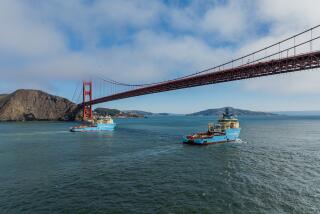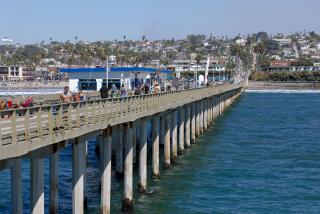Few Beaches in Alaska Require More Cleaning, Exxon Contends
- Share via
ANCHORAGE, Alaska — Asserting that winter storms washed many dirty beaches clean, Exxon said Thursday it believes “few (beaches) will require treatment” when the oil company resumes its cleanup of last year’s 10.8-million-gallon oil spill from the tanker Exxon Valdez.
The company speculated in its 1990 general cleanup plan that as little as 32 miles of the more than 1,000 miles of beaches fouled by the spill still qualify for cleaning, which it said will probably consist of such low-tech tasks as shoveling up rock-crusted tar mats and fertilizing natural oil-eating microbes normally found on the beach.
But Exxon Corp. President Lee R. Raymond said his company still is dedicated to spending whatever time and money is needed for a “reasonable” completion of the cleanup.
Last year, he said, Exxon spent more than $2 billion responding to the disaster, which resulted when the Exxon Valdez strayed out of well-marked shipping lanes to avoid icebergs and ran aground on a well-documented reef shortly after midnight last March 24.
Before it could be salvaged, the crippled supertanker spilled a fifth of its cargo into the wildlife-rich waters of scenic Prince William Sound, creating the worst oil spill in U.S. history.
Alaska Gov. Steve Cowper, a vocal critic of Exxon and its initial cleanup efforts last April, said he agreed with the general approach of Exxon’s tentative cleanup plan.
“Their general portrayal of how the work is going to proceed--small groups employing site-specific technology on a small scale--is just what we think is needed,” he said in a telephone interview from the state capital, Juneau.
Dennis Kelso, commissioner of Alaska’s Department of Environmental Conservation, said a moderately heavy oil sheen is still found on the waters of Prince William Sound south of Valdez, so Exxon’s preliminary plan is not likely to be the final word on what will happen when the cleanup resumes, probably in May.
“I don’t think we should focus on this document as the blueprint, but as one of the things to look at when we decide what needs to be done,” he told an informal gathering of reporters at his Anchorage office.
Both Kelso and Raymond agreed that a more detailed spring cleanup plan--one that prescribes customized cleaning for each segment of oil-fouled shore--will have to wait until after a joint beach survey is conducted, starting March 28 and lasting through April.
In that survey, state and federal scientists as well as Exxon consultants will visit, examine and sample every mile of beach suspected of containing spilled oil, then come to a consensus about the best way to treat each beach segment. The Coast Guard, the lead agency in charge of overseeing the cleanup, will then use those reports to assemble a work plan.
Exxon, which has moved its cleanup headquarters to Anchorage from the tiny port town of Valdez because of larger warehousing capacity in the state’s biggest city, made it clear Thursday that it believes the bulk of cleanup work has already been done, either by its army of 12,000 workers last year or by the Gulf of Alaska’s fabled winter storms.
“Fortunately, while we could not work over the winter, Mother Nature could--and did,” said Otto Harrison, Exxon’s Alaska Operations Manager. “And she was as effective as we could hope.”
The company contends that the storms washed away more than half of the remaining oil, and that the work needed to clean up what little remains on many beaches would cause more environmental damage than simply leaving alone the oil and the asphalt it has created.
More to Read
Sign up for Essential California
The most important California stories and recommendations in your inbox every morning.
You may occasionally receive promotional content from the Los Angeles Times.













